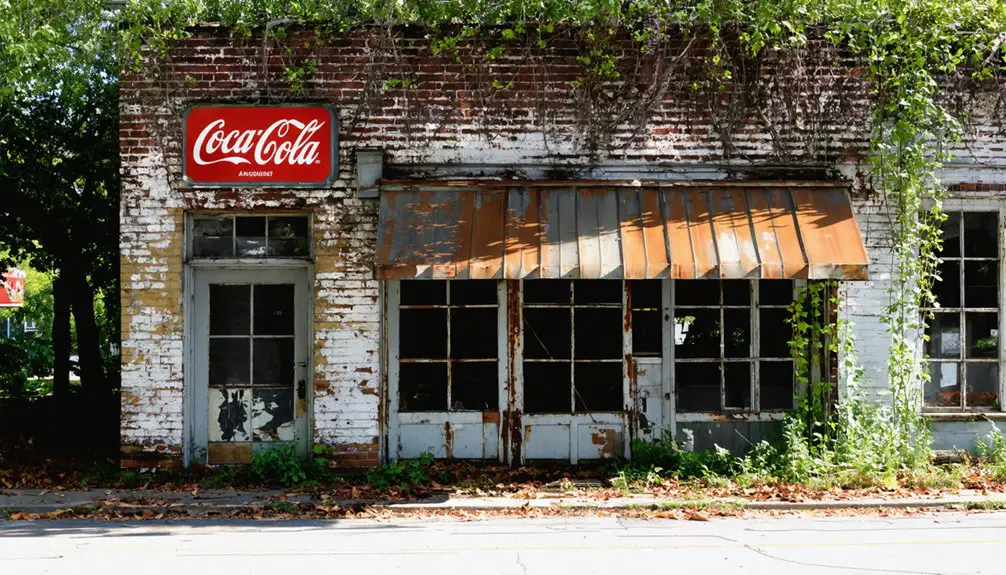You’ll find Gainesville’s ghost town legacy beneath NASA’s rocket testing facility, but its history began as a thriving 19th-century port town on the Pearl River. Originally called Cottonport, Dr. Ambrose Gaines secured a Spanish land grant in 1810 and renamed it. The town flourished with steamboat trade, lumber mills, and cultural growth until economic shifts and railroad bypasses led to its decline. Its final transformation came in 1961 when NASA acquired the land, forever changing this historic settlement’s destiny.
Key Takeaways
- Gainesville transformed from a thriving Mississippi river port town into a ghost town after being bypassed by major railroad developments.
- NASA acquired the abandoned town’s land in 1961 for a rocket testing facility, leading to the final displacement of remaining residents.
- Economic decline began when the Pearl River’s importance diminished, causing businesses and sawmills to relocate elsewhere.
- Three devastating fires, including the 1853 courthouse fire, destroyed vital records and contributed to the town’s gradual abandonment.
- Originally established as Cottonport in the 1730s, Gainesville flourished through river trade before experiencing population decline in the late 1800s.
From Cottonport to Gainesville: Origins and Early Settlement
While French explorers first visited the site in the 1730s, the area that would become Gainesville began as Cottonport, the first European-settled town in northern Mississippi.
You’ll find its origins strategically placed on the Tombigbee River‘s east bank, at the intersection of important Native American trails. The U.S. government built a cotton gin there in 1801, encouraging Chickasaw adoption of European-American customs. The area held particular significance as Levi Colbert, an influential Chickasaw chief, resided nearby. The early settlers faced similar challenges to Captain Frost’s family, with Native American attacks forcing temporary relocations.
Early settlers established Cottonport, also known as English Bluff, as a thriving trading post.
Along the Tombigbee River, Cottonport grew from a modest outpost into a bustling center of commerce and trade.
In 1810, Dr. Ambrose Gaines secured a 500-acre Spanish land grant and renamed the settlement Gainesville. The Frost family’s arrival brought mills and stores, while the construction of Gaines Trace in 1811-12 connected the settlement to Muscle Shoals and Fort Stoddert, expanding trade opportunities.
Life Along the Pearl River: A Bustling Port Town
You’d find Gainesville’s Pearl River bustling with daily boat services that connected the town to Pearlington and Logtown, facilitating crucial passenger and freight movement well into the 1920s.
The river served as a vital commercial artery, with vessels transporting timber, cotton, and agricultural products downstream to lucrative markets like New Orleans.
During paydays at local mills, the waterfront would come alive as boats delivered fresh fruits and produce, while floating taverns attracted visitors from across the river during Mississippi’s early prohibition era.
To avoid confusion with other locations sharing the name, this Gainesville was often referred to as Pearl River Gainesville.
Dr. Ambrose Gaines founded the settlement in the early 1800s after receiving a Spanish land grant to establish the town.
River Trade Activities
During its prime years, Gainesville thrived as a bustling port town along the Pearl River, with daily boat services connecting it to Pearlington and Logtown until 1930.
You’d find freight innovations that kept the town’s commerce flowing, with steamboats arriving twice weekly to transport cotton bales to New Orleans for $1.50 each. Harvey Gill’s keel boat made monthly trading voyages, pioneering early river commerce in the region. The river trade created natural social gatherings, as farmers brought their fruits and produce to sell on lumber mill paydays.
The Pearl River Steam Packet and other vessels linked interior towns like Carthage and Jackson to New Orleans starting in the 1840s. Dr. Ambrose Gaines established the town with a Spanish land grant in 1810, setting the foundation for its maritime success.
You could ship goods at varied rates – fifty cents per dry barrel or $2.50 per 100 pounds on return trips, making Gainesville a crucial hub in the region’s commercial network.
Pearl’s Early Port Life
Beyond its bustling river trade, Gainesville flourished as a vibrant port town with rich civic and social life in the mid-19th century.
You’d find hotels, stores, and even dancing schools along the high, dry banks of the Pearl River, where cultural exchanges between Native Americans, European settlers, and African Americans shaped the community’s character. The name of the river itself derives from the French word perle, reflecting the early French influence in the region.
The town’s importance grew with the establishment of a post office in 1840 and the publication of the Gainesville Advocate in 1845.
By 1852, you could send your children to the local academy, while steam mills and cotton operations drove the economy.
The Pearl River’s strategic location attracted diverse businesses, though you might’ve encountered some rough-and-tumble culture at the floating barrooms that served river workers near the shore.
Tragically, a devastating fire in 1853 destroyed the Gainesville Courthouse and many original land records of the area.
The Lumber Empire: Poitevent-Favre’s Legacy
The remarkable Poitevent-Favre lumber empire emerged from humble beginnings in 1866 when brothers-in-law John Poitevent and Joseph Favre established their operation in Pearlington, Mississippi.
Their business quickly drove economic transformation across the region, becoming Mississippi’s largest mill by 1870 with over 150 workers. The company later built their impressive “Big Jim” mill that could produce 200,000 board feet daily. The devastating yellow fever epidemic of 1878 caused significant mortality in the region but failed to stop the company’s growth.
- Built an impressive fleet of fifteen schooners, four tugboats, and one sternwheeler for domestic and international shipping
- Supplied critical materials for the Mobile and New Orleans Railroad construction
- Provided lumber for James B. Eads’ Mississippi River jetty project in 1874
Despite facing federal land disputes, yellow fever epidemics, and devastating hurricanes, the company’s operations persisted through 1904, leaving an indelible mark on regional development and commerce.
Courthouse Fire and Lost Records: A Historical Gap
You’ll find few remnants of Gainesville’s early history due to the devastating courthouse fire of 1853, which destroyed most county records and documents housed in the building.
The blaze created an extensive historical gap, making it difficult to trace property ownership, court cases, and daily life in pre-1853 Gainesville.
This loss of primary documentation forces historians to rely heavily on newspapers like the Gainesville Advocate and private journals to piece together the town’s past.
1853 Devastating County Blaze
When flames engulfed Gainesville’s courthouse in 1853, they marked the first of three devastating fires that would plague Hancock County’s governmental infrastructure throughout the 19th century.
The fires didn’t just destroy the courtroom architecture; they erased vital records that documented the region’s early history.
You’ll find the historical resilience of Hancock County reflected in how officials adapted after each blaze:
- Court sessions moved between temporary locations as the community worked to rebuild
- By 1867, the county seat relocated to Bay Saint Louis, leading to new courthouse construction
- A wooden structure arose in 1874, followed by a more durable brick courthouse in 1911-1912
These fires mirror a common pattern across the South, where courthouse disasters created significant gaps in historical documentation.
Missing Historical Documentation Impact
Devastating fires that consumed Gainesville’s courthouse left more than just physical destruction in their wake – they created profound gaps in Hancock County’s historical record.
You’ll find the loss particularly impactful when researching land ownership, as the flames destroyed vital property deeds and land grants dating back to the early 1800s. This has led to ongoing property disputes and boundary uncertainties that persist today.
The fire’s destruction extends beyond property records, creating significant genealogical challenges for those tracing their family histories.
Birth, death, and marriage records before 1853 largely vanished, while documentation of enslaved populations disappeared entirely.
Though census records remain available, you won’t find the rich details that court and church records once provided. These gaps continue to challenge historians working to piece together Gainesville’s economic and social development.
Lost Town Data Effects
The catastrophic 1853 courthouse fire in Gainesville created an irreparable void in Hancock County’s historical record, effectively erasing essential documentation of the town’s early development.
This profound loss of heritage has left you with significant challenges in understanding your community’s roots and evolution. Without these vital records, you’ll find gaps in land ownership histories, political decisions, and demographic data that once shaped Gainesville’s identity.
- The fire’s destruction of official documents has severely limited your ability to trace family histories and property records.
- You’ll notice how the lost community identity accelerated Gainesville’s transformation into a ghost town.
- NASA’s development in the 1960s further complicated your chances of archaeological preservation, making it harder to piece together the town’s past through physical evidence.
Economic Shifts: From River Trade to Railroad Era
During its economic heyday, Gainesville flourished as an essential river trade hub along the Pearl River, where steamboats regularly transported goods, passengers, and lumber products throughout the region.
The Pearl River Lumber Company, established in 1832, dominated the local economy and helped establish Gainesville as the South’s premier lumber center.
Founded in 1832, the Pearl River Lumber Company transformed Gainesville into a dominant force in Southern lumber production.
However, you’ll find that the transportation change to railroads in the mid-1800s marked the beginning of Gainesville’s economic decline.
When a major rail line bypassed the town by ten miles, businesses and sawmills relocated northward to railroad-accessible areas like Nicholson.
The shift proved fatal for Gainesville’s river-based commerce, as freight and timber operations favored faster rail transport.
The Last Days: A Community’s Twilight Years

As economic forces pushed residents away from Gainesville in the late 19th century, the once-thriving river town entered its final decline phase.
Despite the community’s resilience, environmental challenges and changing transportation patterns sealed its fate. You’ll find that by the mid-20th century, Gainesville’s historical significance was fading into memory.
- Recurring floods and fires accelerated the deterioration of buildings, while abandoned structures fell victim to neglect and weather damage.
- The few remaining families struggled against the swampy terrain and diminishing economic opportunities until NASA’s acquisition in the 1960s.
- The town’s final chapter closed when federal authorities took control, erasing the last traces of municipal identity and relocating the surviving residents.
NASA’s Arrival: The End of an Era
In 1961, NASA’s search for a rocket testing facility led them to the dwindling community of Gainesville, where fewer than 50 families still called home.
In a quiet corner of Mississippi, NASA discovered the perfect location for their ambitions – a fading town called Gainesville.
By 1962, this quiet Mississippi town would experience a cultural shift that would forever alter its destiny. You’ll find that NASA’s arrival marked both progress and pain – while bringing cutting-edge aerospace technology to Hancock County, it also meant community displacement for Gainesville’s remaining residents.
The change wasn’t smooth. Many locals first learned about their fate from real estate assessors rather than official channels.
Even Senator John Stennis had to address mounting tensions at a public forum. While NASA initially used some historic structures, including the Rouchon House for their first flag-raising ceremony, this once-timber town would soon vanish beneath America’s largest rocket testing facility.
Preserving the Past: Archaeological Discoveries
Recent archaeological excavations at the former Gainesville site have revealed a rich tapestry of historical and prehistoric artifacts.
You’ll find evidence of both colonial settlement and Native American habitation, highlighting the area’s profound archaeological significance. Through ground-penetrating radar and careful excavation, researchers have uncovered a wealth of cultural heritage that spans centuries.
- Domestic artifacts like porcelain doll fragments, transfer-ware ceramics, and square nails paint a vivid picture of 19th-century family life.
- Prehistoric tool-making debris indicates Native American settlement long before European arrival.
- Animal remains and structural evidence discovered through GPR technology reveal patterns of settlement and hunting practices.
These discoveries don’t just preserve Gainesville’s past – they’re revealing secrets about the region’s complex cultural shifts and development through time.
Gainesville’s Impact on Regional Development
During the mid-19th century, Gainesville’s strategic location on the Pearl River established it as a significant economic force that shaped Mississippi’s regional development.
You’ll find that the town’s economic evolution mirrored broader industrial changes sweeping through the South. As the county seat, Gainesville wielded administrative power while fostering community resilience through its bustling lumber industry, shipbuilding facilities, and vibrant social venues.
When railroads emerged as the dominant transportation mode, bypassing Gainesville by 10 miles, the town’s influence waned dramatically.
Yet its legacy lived on as the land transformed to serve a new purpose – the NASA Stennis Space Center. This shift from river commerce to aerospace technology perfectly illustrates how Gainesville’s territory continued to play a vital role in regional economic advancement, albeit in an entirely different capacity.
Frequently Asked Questions
What Happened to the Graves and Cemeteries When NASA Acquired the Land?
When NASA acquired your land, they conducted grave relocations to other cemeteries outside the area, though some cemeteries were preserved within the buffer zone and you’re still allowed to visit them.
Are There Any Surviving Photographs of Gainesville During Its Peak Years?
Ever wonder about those peak years? You’ll find limited historical documentation through archival research, with some photos maintained by historical societies showing port activities, sawmills, and riverboats from the 1800s.
Did Any Original Gainesville Families Receive Compensation for Their Displaced Properties?
While you’d expect records of a compensation process for displaced families, there’s no direct evidence confirming payments were made. Historical documentation doesn’t reveal if property owners received fair compensation.
What Natural Disasters Affected Gainesville Before Its Decline and Abandonment?
Mother Nature’s wrath showed no mercy – you’d have seen devastating hurricane damage along the Gulf Coast and recurring Pearl River floods that repeatedly disrupted shipping, damaged infrastructure, and weakened the local economy.
Can Tourists or History Enthusiasts Visit Any Remaining Structures at the Site?
You can’t visit remaining structures since tourist access is prohibited – the site lies within NASA’s restricted Stennis Space Center, with no historical preservation areas open to public exploration.
References
- https://en.wikipedia.org/wiki/Gainesville
- https://www.onlyinyourstate.com/experiences/mississippi/ms-ghost-towns
- https://mississippifolklife.org/articles/haunted-by-a-ghost-town-the-lure-of-rodney-mississippi
- https://www.hancockcountyhistoricalsociety.com/history/gainesville-dig
- https://www.youtube.com/watch?v=n-pwtBwbqUE
- https://en.wikipedia.org/wiki/Cotton_Gin_Port
- https://www.historythroughhomes.com/post/john-frost-house-aka-cottonport-the-original-brentwood-settlement
- https://www.mshistorynow.mdah.ms.gov/taxonomy/term/4?page=11
- https://www.nps.gov/parkhistory/online_books/explorers/intro14.htm
- https://www.hancockcountyhistoricalsociety.com/vignettes/gainesville/



